Water management is one of the most powerful forces shaping modern Taiwan’s landscapes and politics. Many of Taiwan’s township and county boundaries are defined by watersheds. The current course of the mighty Jhuoshuei River (濁水溪) was largely established by Japanese embankment building during the 1918-1923 period. Taoyuan is dotted with ponds constructed by settlers from China during the Qing period. Countless local civic actions have been driven by opposition to water projects.
Last week something like 2,600mm of rain fell on southern Taiwan in seven days, peaking at over 2,800mm in Duona (多納) in Kaohsiung’s Maolin District (茂林), according to the government. This figure was dangerously close to the record rainfall of Typhoon Morakot in 2009. The populated areas in the south were in the news, but the Taipei Times reported that Taitung Weather Station Director Jan Li-chun (冉立群) said that a weather station in Taitung County’s Dawu Township (大武) recorded 1,851.5mm of rainfall last month, the highest for the month since the station was established in 1939.
FLOOD CONTROL
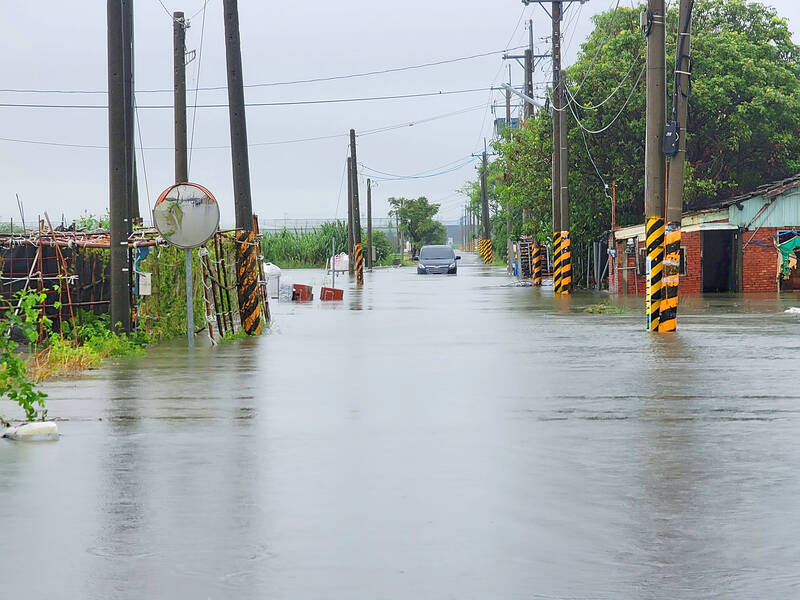
Photo courtesy of reader
Social media platforms were overrun with images of flooding in areas of southern Taiwan hard-hit by the heavy rain, especially Tainan. Instantly relatable disaster imagery like flooding, with its implied criticism of the authorities, makes for large numbers of clicks. What viewers did not see, however, were images of successful flood control and water management programs, and of the ceaseless army of workers and engineers that keep Taiwan safe from water. The nation was hit with near-record rainfall levels, but only a handful of deaths resulted, and flooding did not result in widespread destruction.
Flood control infrastructure operates without fanfare. The people it saves are largely unaware of its existence. Consider: how many readers have ever heard of the the Yuanshantze Flood Diversion Tunnel (員山仔分洪道), which entered service in 2005? Spurred by massive flooding of Taipei due to typhoons Lynn in 1987 and Nari in 2001 (which flooded 6,600 hectares of Taipei), it is designed to take overflows from the Keelung River from a depression near Ruifang and dump them directly in the ocean to the northeast through a tunnel 2483 meters long.
By diverting overflows, the tunnel made it unnecessary for the government to acquire private land for a floodplain and spend extra money strengthening downstream bridges. Things that do not happen go unseen by taxpayers, but they are just as important as things that can be seen. Today the tunnel protects 2 million people living downstream in the heavily developed river basin, a silent but successful project.

Photo courtesy of Wutai Township Mayor Ba Cheng-yi
The city of Tainan was victimized by the recent rainfall. The government said that 13 of Tainan’s 37 administrative districts saw rainfall in excess of 40mm an hour, overwhelming its pumps and drainage systems. Local administrators activated 54 pumps, removing over 3.2 million tons of water. The July-August rains came on the heels of June rains that also saw the city pounded by rainfall.
Premier Cho Jung-tai (卓榮泰), visiting Tainan at the end of last month, said that the Executive Yuan plans to establish a Flood Response Command Center in Yunlin, Chiayi and Tainan counties (which could serve as a basis for a future merging of the two counties into Tainan to form a larger municipality in the next decade). Cho also said that the government will prioritize flood mitigation projects suggested by local authorities in the next multi-year flood control budget. At the end of last month the Executive Yuan approved a budget to expedite a drainage improvement project, reducing the time from six to four years, in response to the serious flooding in central and southern Taiwan, with a total funding of NT$10 billion (US$334 million). The water budget was already getting a boost due to the damage in Yilan from typhoon Kong-rey last November.
PROTECTING FLOOD-PRONE AREAS
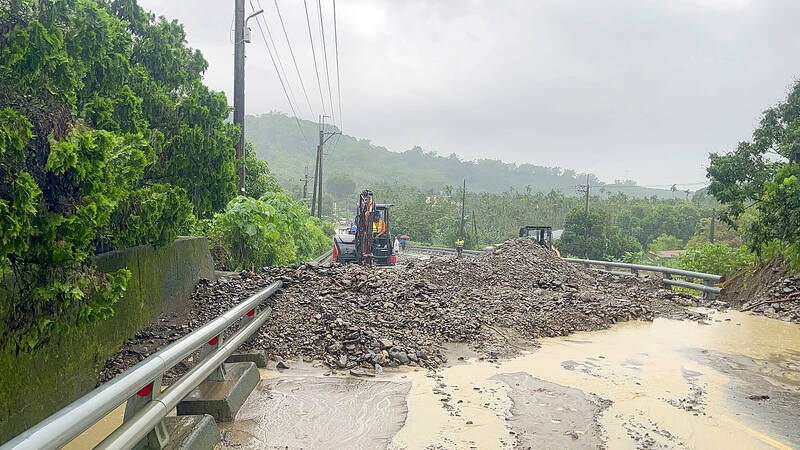
Photo: Luo Hsin-jen, Taipei Times
Successive administrations have all put money into water management infrastructure, which offers political parties the happy coincidence of being able to splash cash across their local patronage networks while protecting local constituents. In recent years probably the most important of these was the Forward-looking Infrastructure Development Program (FIDP) of the Tsai Ing-wen (蔡英文) administration. The FIDP was intended as a comprehensive initiative targeting Taiwan’s key infrastructure needs over the next three decades, taking into account global warming. Water management and infrastructure was budgeted at around NT$25 billion (US$833 million) for the first stage of the FIDP ending 2018. Laudably, it was the second largest of the FDIP’s eight focus areas.
The government classifies 1,150 of Taiwan’s 36,197 square kilometers as flood prone. The FDIP mandated 100 kilometers of local government-managed levees and drainage channels to protect 50 hectares of that area. Previous programs had protected 688 square kilometers of the 1,150 considered threatened. That may not sound like much, but the protected areas encompass some of the nation’s most heavily built up areas. The overall program, which ends this month, protects a total of 250 square kilometers, expands sewer systems by 115 kilometers, and adds 190 kilometers to rivers and drainage systems.
Despite the ongoing investment, as the rain showed, numerous problems remain. Gaoshu Township (高樹), a low-lying area in Pingtung prone to flooding in heavy rain, was clobbered once again, likely due to silting and to longtime water management programs that have concreted the banks and beds of streams across Taiwan. Perhaps it is time for the government to consider buyouts of perennial flood regions in the south. Farmers in affected areas across the south filed for disaster relief, but as of last week the government had yet to define how funds would be disbursed.
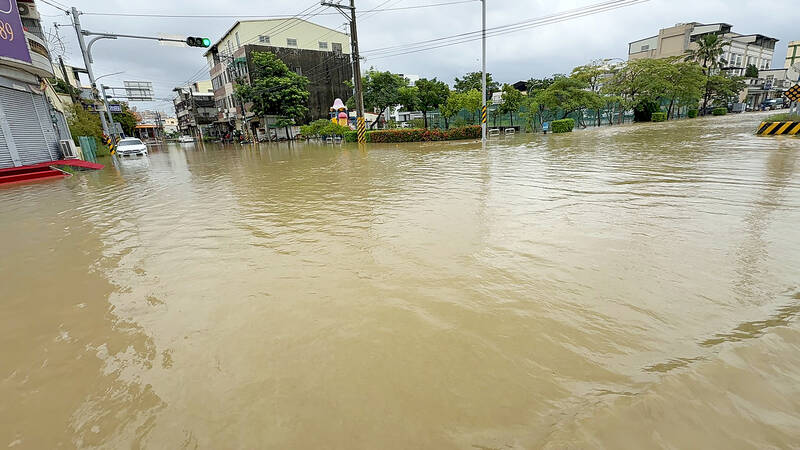
Photo: Lee Wen-te, Taipei Times
The Acting Secretary-General of the Democratic Progressive Party (DPP), Ho Po-wen (何博文), provided some comic relief by personally going to Tainan to clear ditches. In fine Taiwan style, he challenged his critics who accused him of engaging in photo ops to come help clear the ditches. More to the point, former DPP Legislator Kuo Cheng-liang (郭正亮) was among many who publicly criticized the DPP for expending its local water resource funding on infrastructure while neglecting the simple but vital act of drain clearing. The attacks had another target: Tainan has long been a DPP fiefdom and is the current president’s home base.
The criticisms of the DPP were a reminder that the south, where the rain wreaked havoc, is heavily pro-DPP, meaning that the party must display contrition and competence or risk further sliding in the region. Recall, for example, that the 2022 Tainan mayoral election was a 48.8 percent to 43.6 percent DPP victory, much closer than the previous blowouts in favor of the DPP. The pro-China parties in the legislature may attempt to attack additional spending on water management as wasteful or misguided, as they did when the FIDP was first announced a decade ago, or perhaps slash water funding and then blame the DPP for the resulting problems.
Whatever happens, the progress since Morakot is obvious. Kudos to our water resource managers and planners.
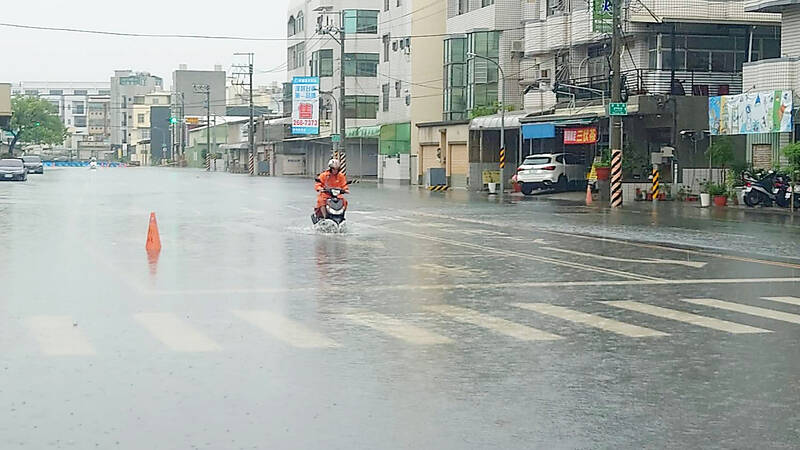
Photo: Hung Jui-chin, Taipei Times
Notes from Central Taiwan is a column written by long-term resident Michael Turton, who provides incisive commentary informed by three decades of living in and writing about his adoptive country. The views expressed here are his own.

The Taipei Times last week reported that the rising share of seniors in the population is reshaping the nation’s housing markets. According to data from the Ministry of the Interior, about 850,000 residences were occupied by elderly people in the first quarter, including 655,000 that housed only one resident. H&B Realty chief researcher Jessica Hsu (徐佳馨), quoted in the article, said that there is rising demand for elderly-friendly housing, including units with elevators, barrier-free layouts and proximity to healthcare services. Hsu and others cited in the article highlighted the changing family residential dynamics, as children no longer live with parents,

It is jarring how differently Taiwan’s politics is portrayed in the international press compared to the local Chinese-language press. Viewed from abroad, Taiwan is seen as a geopolitical hotspot, or “The Most Dangerous Place on Earth,” as the Economist once blazoned across their cover. Meanwhile, tasked with facing down those existential threats, Taiwan’s leaders are dying their hair pink. These include former president Tsai Ing-wen (蔡英文), Vice President Hsiao Bi-khim (蕭美琴) and Kaohsiung Mayor Chen Chi-mai (陳其邁), among others. They are demonstrating what big fans they are of South Korean K-pop sensations Blackpink ahead of their concerts this weekend in Kaohsiung.

Taiwan is one of the world’s greatest per-capita consumers of seafood. Whereas the average human is thought to eat around 20kg of seafood per year, each Taiwanese gets through 27kg to 35kg of ocean delicacies annually, depending on which source you find most credible. Given the ubiquity of dishes like oyster omelet (蚵仔煎) and milkfish soup (虱目魚湯), the higher estimate may well be correct. By global standards, let alone local consumption patterns, I’m not much of a seafood fan. It’s not just a matter of taste, although that’s part of it. What I’ve read about the environmental impact of the
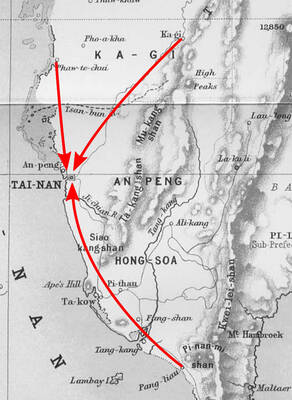
Oct 20 to Oct 26 After a day of fighting, the Japanese Army’s Second Division was resting when a curious delegation of two Scotsmen and 19 Taiwanese approached their camp. It was Oct. 20, 1895, and the troops had reached Taiye Village (太爺庄) in today’s Hunei District (湖內), Kaohsiung, just 10km away from their final target of Tainan. Led by Presbyterian missionaries Thomas Barclay and Duncan Ferguson, the group informed the Japanese that resistance leader Liu Yung-fu (劉永福) had fled to China the previous night, leaving his Black Flag Army fighters behind and the city in chaos. On behalf of the